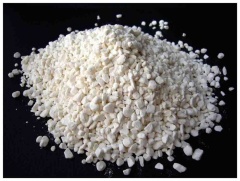Potassium
| Infobox on Potassium | |
|---|---|
| Example of Potassium |  |
| Facts | |
| Origin | - |
| Stowage factor (in m3/t) | 0,81 to 1,12 m3/t |
| Humidity / moisture | - |
| Ventilation | - |
| Risk factors | See text |
Potassium
Description
Potassium is the chemical element with the symbol K (from Neo-Latin kalium) and atomic number 19. Elemental potassium is a soft silvery-white alkali metal that oxidizes rapidly in air and is very reactive with water, generating sufficient heat to ignite the hydrogen emitted in the reaction.
Potassium and sodium are alkali metals and are chemically very similar. For this reason it took a long time before their salts were differentiated. They were suspected to be different elements within their salts after 1702, and this was proven in 1807 when potassium and sodium were individually isolated from different salts by electrolysis. Potassium in nature occurs only in ionic salts. As such, it is found dissolved in seawater (which is 0.04% potassium by weight), and as part of many minerals.
Most industrial chemical applications of potassium employ the relatively high solubility in water of potassium compounds, such as potassium soaps. Potassium metal has only a few special applications, being replaced in most chemical reactions with sodium metal.
Potassium ion is necessary for the function of all living cells. Potassium ion diffusion is a key mechanism in nerve transmission, and potassium depletion in animals, including humans, results in various cardiac dysfunctions. Potassium is found in especially high concentrations within plant cells, and in a mixed diet, it is mostly concentrated in fruits. The high concentration of potassium in plants, associated with comparatively low amounts of sodium there, historically resulted in potassium first being isolated from potash, the ashes of plants, giving the element its name. Heavy crop production rapidly depletes soils of potassium, and agricultural fertilizers consume 95% of global potassium chemical production.
Potassium is an extremely active metal, which reacts violently with oxygen and water in air. With oxygen, it converts to potassium peroxide and with water Potassium Hydroxide. The reaction of potassium with water is dangerous because of its violent exothermic character and the production of hydrogen gas. Hydrogen reacts again with atmospheric oxygen, producing water, which reacts with the remaining potassium. This reaction requires only traces of water; because of this, potassium and its liquid alloy with sodium — NaK — are potent desiccants that can be used to dry solvents prior to distillation.
Because of the sensitivity of potassium to water and air, the reactions are possible only in inert atmosphere, such as argon gas using air-free techniques. Potassium does not react with most hydrocarbons, such as mineral oil or kerosene. It readily dissolves in liquid ammonia, up to 480 g per 1000 g of ammonia at 0 °C. Depending on the concentration, the ammonia solutions are blue to yellow, and their electrical conductivity is similar to that of liquid metals. In a pure solution, potassium slowly reacts with ammonia to form KNH2, but this reaction is accelerated by minute amounts of transition metal salts. It can reduce the salts to the metal; potassium is often used as the reductant in the preparation of finely divided metals from their salts by the Rieke method.
Application
Use; preparation of potassium peroxide, heat exchange alloys; laboratory reagent, sending of combustion gases in magnetohydrodynamic generators, component of fertilizers (as potassium chloride).
Shipment / Storage / Risk factors
Hazard: Dangerous fire risk, reacts with moisture to form potassium hydroxide and hydrogen. The reaction evolves much heat, causing the potassium to melt and spatter. It also ignites the hydrogen. Burning potassium is difficult to extinguish; dry powdered soda ash or graphite or special mixture of dry chemicals are recommended. It can ignite spontaneously in moist air. Moderate explosion risk by chemical reaction. Potassium metal will form the peroxide and the superoxide at room temperature even when stored under mineral oil; may explode violently when handled or cut. Oxide-coated potassium should be destroyed by burning. Store in inert atmospheres, such as argon or nitrogen or under liquids which are oxygen-free, such as toluene or kerosene, or in glass capsules which have been filled under vacuum or inert atmosphere.
This cargo is hygroscopic and will cake if wet.
For overseas carriage consult the IMSBC Code (International Maritime Solid Bulk Code) as published by IMO (International Maritime Organization); the IMDG Code and applicable MSDFS sheet.











